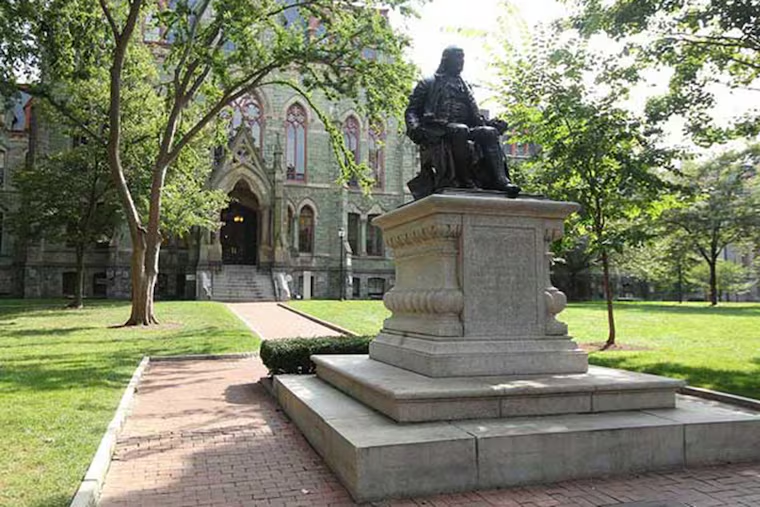With testing requirements relaxed, applications soar at selective colleges
The University of Pennsylvania received 55,992 applications, a 34% increase from the year before. Haverford College was up 16%, Princeton 15%, Swarthmore 12% and Villanova 10%. Harvard rose 42%.

As the pandemic disrupted education, many colleges — even the most highly selective — waived their requirement that applicants submit standardized test scores for fall 2021 admission.
And the applications rolled in.
The University of Pennsylvania received 55,992, a 34% increase from the year before. Haverford College saw a 16% rise, one of its highest increases in the last 15 years. Princeton’s applications rose 15%, Swarthmore’s 12% and Villanova’s 10%. Harvard received more than 57,000 applications, a 42% increase.
» READ MORE: Penn is the latest local university to drop the SAT requirement for admission because of the coronavirus
“We certainly think for highly selective schools that went test optional, that played a large role in the number of applications they received,” said Lindsay Addington, director of global engagement for the National Association for College Admission Counseling.
Students who are not strong test-takers but high academic performers may have felt more empowered to try, she said.
The increased applications, including many from students without SAT or ACT scores, will make for a more challenging selection cycle, as counselors drill down on grades, essays, recommendations, and other measures, knowing students’ high school careers were upended by the pandemic to varying extents. The Ivy League universities, including Harvard, Princeton, and Penn, have said they will delay announcing admissions decisions until April 6, about a week later than normal, to allow more time.
» READ MORE: Haverford College scraps standardized test requirement amid pandemic
With more competition, students may find it even more difficult to get into the most elite schools.
“At Swarthmore, it’s going to be more selective, even on the same sized class,” said Jim Bock, vice president and dean of admissions.
Bock said about two-thirds of Swarthmore’s growth could be attributed to international applicants. Officials at Princeton and Haverford also noted a rise in those applicants, and that trend proved true on a larger scale. Common App, the nonprofit that oversees the Common Application, which allows students to apply to multiple schools with one application, noted double-digit increases in applications from India, Canada, Pakistan, the United Kingdom, and Brazil, though applications from China declined 18%.
The deadline for applications came after the presidential election and as vaccines began to roll out.
“We are, in fact, hearing anecdotally from international counselors that the perception of a more welcoming federal administration may be inspiring more international students to consider the U.S. this year,” said Shawn Abbott, vice provost for admissions, financial aid, and enrollment management at Temple University.
The influence of Vice President Kamala Harris, whose mother was from India, may have helped drive up applications from that country, Addington said. She also said international students may have applied to more colleges in multiple countries, waiting to see which campuses are able to reopen fully in the fall.
And that may be true of domestic students, too. The Common Application noted a 9% increase in the number of applications submitted per applicant.
Because of the pandemic, many students also had difficulty taking the SAT and ACT. As a result, many colleges began waiving the requirement for admission, at least for the next year or two. Many students appear to have taken colleges up on the offer to forgo exam scores.
At Haverford, about 60% of applicants did not submit scores. At Swarthmore, it was 47%. And more than half of applicants at Villanova also chose not to send scores. Neither Penn nor Princeton shared what percentage of applications came without test scores, but Princeton spokesperson Michael Hotchkiss said that those applicants are not at a disadvantage and that the university would continue to use a “holistic” review.
Bock, at Swarthmore, said having applicants without test scores did not make the selection of early-decision students any harder. Applicants without test scores crossed race, family income levels, and geography, he said.
Colleges also are facing other factors that could make the selection process more difficult, including not knowing if students they admit will choose to come, depending on the pandemic.
Some have larger numbers of students who deferred admission last fall because of the pandemic and that may mean less room for new applicants. At Villanova, more than 20 students deferred admission, said J. Leon Washington, dean of enrollment management.
The admissions process also was hampered by the loss of on-campus tours and admission counselors’ visits to high schools, said Jess Lord, dean of admission at Haverford. Colleges for years have found students who visit tend to be more serious about enrolling.
“Those were important indicators of student interest,” Lord said. “Does a student doing a one-hour Zoom meeting indicate the same level of interest? It’s hard to know.”
Haverford received just under 5,300 applications this year.
Villanova, which received more than 24,300 applications, hosted outdoor admissions tours on campus, with masks and temperature checks, and found that 90% of those who attended applied, Washington said.
Some colleges saw more modest increases. Bryn Mawr didn’t require applicants to submit standardized test scores even before the pandemic. It saw a 3% increase. Temple, which also had been test optional, is running 3% to 4% ahead, with its application deadline Feb. 1.
While Common Application data showed that overall applications climbed 10%, the nonprofit noted a worrisome decline in applications from first-generation students and those who seek application fee waivers.
“We continue to be very concerned” about that decline, said Jenny Rickard, president of Common App.